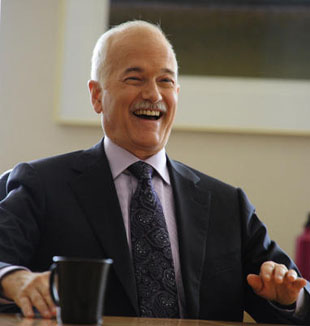A little more evidence April 25 EKOS poll not altogether out to lunch ..
Apr 27th, 2011 | By Randall White | Category: In Brief
NDP leader Jack “You the Man” Layton has suddenly become one happy guy. And why not, of course! Colin McConnell/TORONTO STAR PHOTO.
[UPDATED MAY 1]. Two additional bits of polling data are now offering some degree of support for the dramatic scenario of change in Canadian federal politics this coming Monday, May 2 posed by the April 25 EKOS poll. (In case you’ve forgotten: Conservatives 33.7%, New Democrats 28.0%, Liberals 23.7%, Greens 7.2%, Bloc Quebecois 6.2%, and Other 1.2% . And “with current splits” these numbers would produce, on EKOS President Frank Graves’s projections, 131 Conservative seats, 100 NDP seats, and 62 Liberal seats, giving the NDP and Liberal Party together a parliamentary majority and “31 more seats than the Conservatives, as well as nearly 20 more points in popular vote.”)
The first exhibit is just an update from EKOS itself. This covers the period April 23—25, as opposed to the earlier April 22—24, and gives similar cross-Canada popular vote numbers: Conservatives 33.9%, New Democrats 27.9%, Liberals 24.0%, Greens 6.8%, Bloc Quebecois 6.0%, and Other 1.4%. Mr. Graves also notes that the “Conservative voter is far more enthusiastic and committed than other voters and this should provide a slight premium” for the party “on Election Day.”

Town hall discussion at Vancouver's Alpen Club, April 25, 2011. Photograph by: Mark van Manen, PNG. Liberal leader Michael Ignatieff is still working very hard. And it won’t really be his fault if May 2, 2011 proves the beginning of the end for at least some older view of his party.
The second exhibit is a fresh poll from Angus Reid Public Opinion for April 25—26. It gives these cross-Canada popular vote numbers: Conservatives 35%, New Democrats 30%, Liberals 22%, Bloc Quebecois 7%, and Greens 5%. It also reports, among various other intriguing things: “Three-in-ten Canadians (29%) believe the Conservative government has performed well, and deserves a majority in the House of Commons after the May 2 election. However, a majority of respondents would prefer either a minority for the Tories (15%) or a different party forming the government (43%).”
While neither of the most recent cross-Canada popular vote numbers reported here suggest strong prospects for a Conservative majority, the Angus Reid analysis does also note that “the possibility of a majority mandate for the Conservatives hinges on voter turnout and on the way the centre-left vote will split in the ridings that are being defended by Liberal incumbents.” Evidence on potential voter turnout may have been provided by the advance voting polls: “Elections Canada on Tuesday [April 26] reported a 35-per-cent jump in the number of Canadians that took part in early voting last weekend, with two days having the biggest advance turnout ever.”

NDP leader Ed Broadbent (right) with Progressive Conservative leader Brian Mulroney and Liberal leader John Turner, shortly before a debate in the free trade election of 1988 – when an earlier “NDP surge” proved to have petered out by election day. Photograph by: Wayne Cuddington, Ottawa Citizen.
Commentary on the CBC National news last night raised the prospect that we are now not even dead certain about just who is going to “win” on May 2. But so far all opinion polling still indicates the Harper Conservatives will at least have the largest number of seats. On more interpretive fronts, scepticism about the extent to which the “NDP surge” will finally seriously spoil Mr. Harper’s plans to carry on with whatever it is he has been doing in Ottawa since early February 2006 was expressed yesterday by such disparate commentators as Lawrence Martin in the Globe and Mail and Randy Boswell in the Vancouver Sun.
Still, there does seem some kind of growing consensus that something rather unusual in the “dull as ditch-water” history of Canadian federal politics actually could happen on May 2. It no doubt remains difficult to say just what, exactly. And of course it could still prove to be not all that much. But things are certainly more interesting than they were, as recently as, oh say, this time last week (or even the day before the day before yesterday?)!
UPDATE MAY 1: See the counterweights editors on “Nothing dead certain about end of surprising and unsettling Canadian federal election campaign of 2011.”


I see that they are suggesting in the media that the NDP’s advances will go for nought as this, they said, happened in 1988 during that election campaign. They are wrong. The NDP led in the polls in May of 1987. The election was held in October of 1988. After the NDP’s 1987 poll lead the Liberals led most of the way after that in a three-way split. At around the time the election was called, the PCP jumped above 40% to the lead. The free trade debates gave the Liberals the lead, after which the PCP re-established their lead for the election.